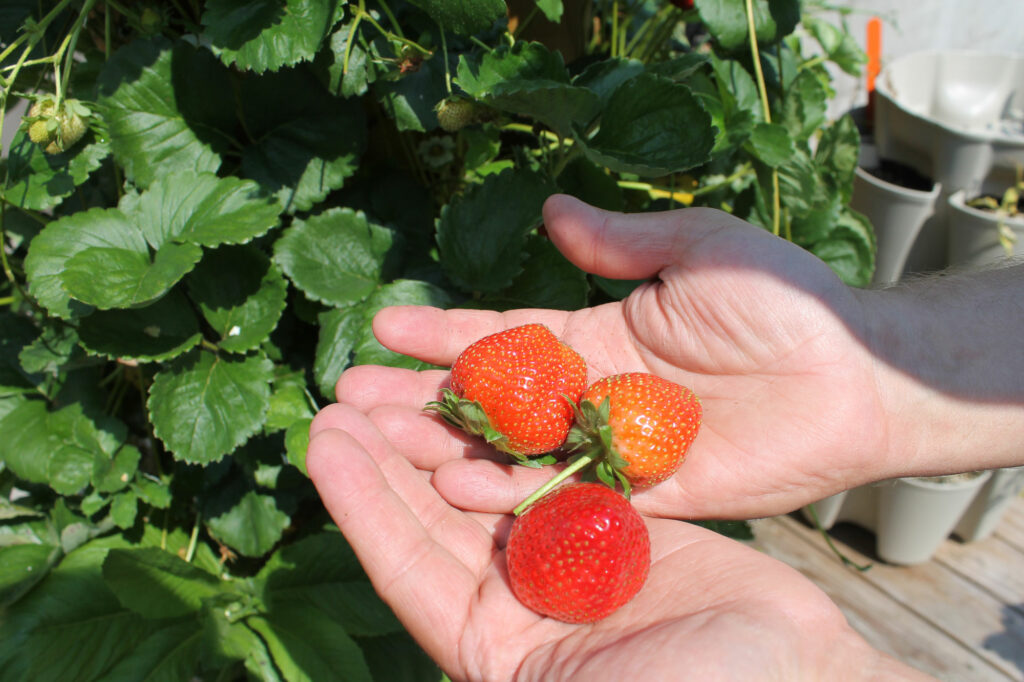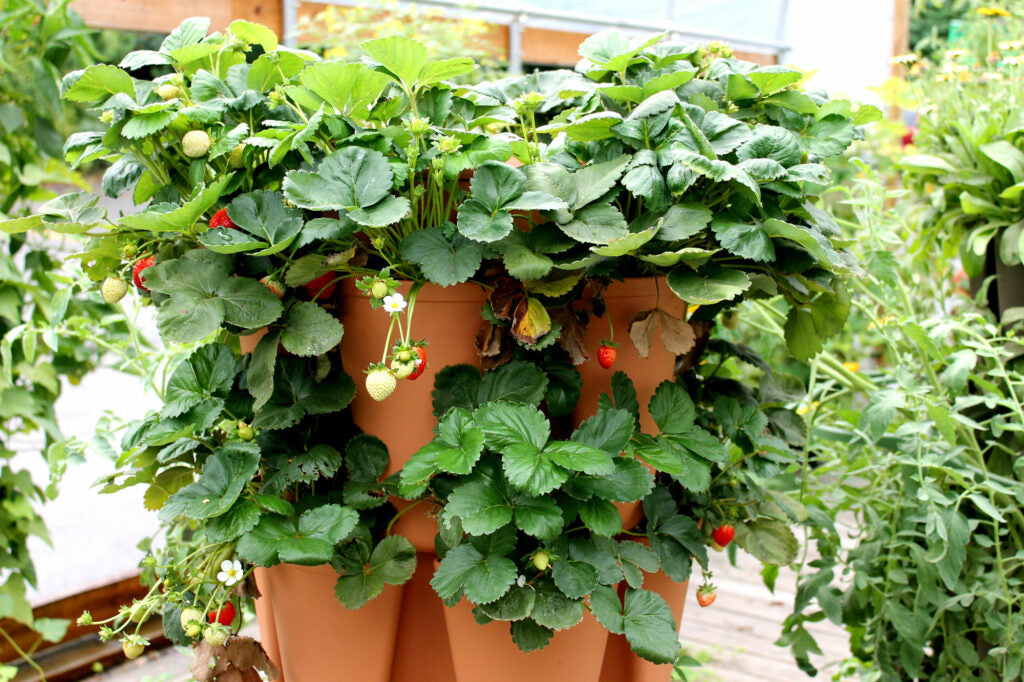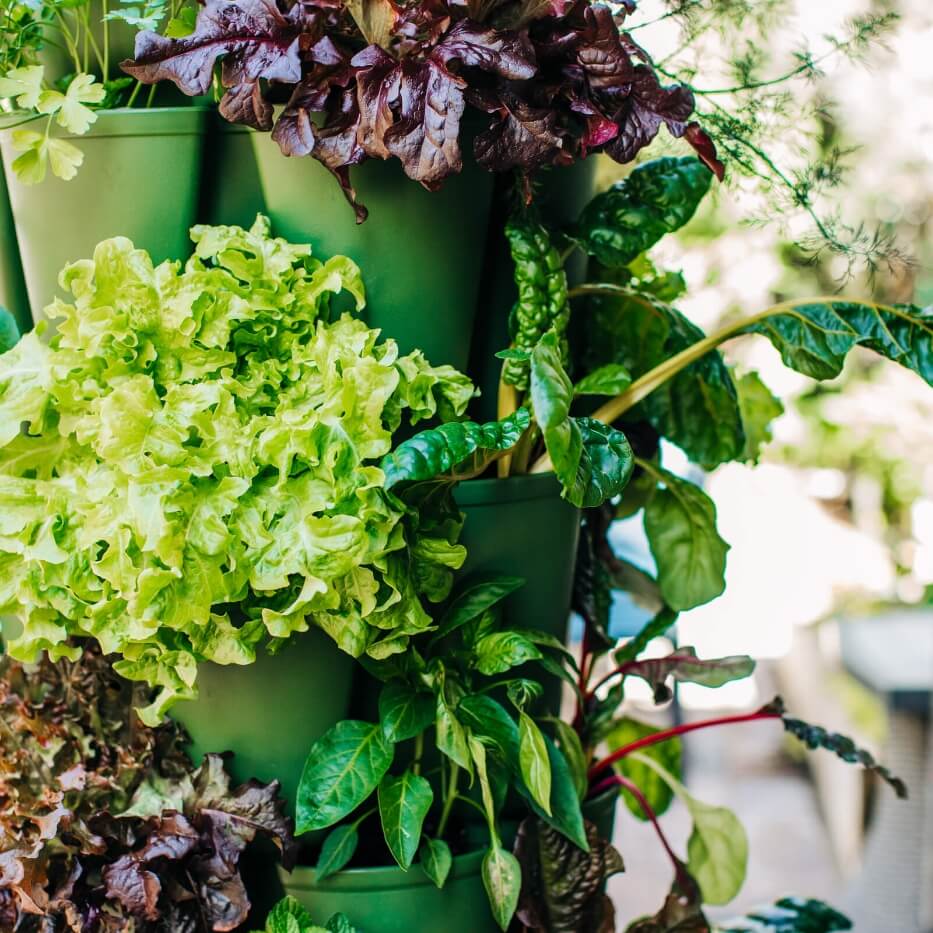Strawberries are one of the most popular plants to grow in a stackable GreenStalk Vertical Planter. They are relatively low maintenance and in most areas, you plant them once and they will come back year after year. Kids love growing and most importantly, harvesting strawberries. They are a great plant to grow and in this post, we will detail exactly how to make your own vertical strawberry planter with minimal work.

Another reason to grow strawberries vertically is that they are ranked really high on the "Dirty Dozen" list. In general, strawberries purchased from the grocery store are more likely to be high in pesticide residue. The great thing about growing them at home is that you control what you put on your plants and in turn control what you consume.
Prep that soil
To help your plants thrive, choose a high-quality potting mix — you don’t want to go for the cheap stuff here. Purchase or make a lightweight fluffy mix that may include ingredients like peat moss, coconut coir, perlite vermiculite, compost, worm castings, etc. Stay away from wood chips, topsoil, and garden soil for container gardens. Strawberries also love acidic soil, so if you’re concerned about the PH of your mix, you can get a meter for about $10 and check it a couple of times a year. Aim for a reading of 5.5-6.8 for strawberry plants.

Difference between Everbearing (Day Neutral) and June Bearing
Strawberries come in two basic types, everbearing and June bearing. Everbearing varieties will produce a smaller amount of strawberries for a longer period of time. June-bearing strawberries will produce one large harvest for a short amount of time (about 6 weeks) and are done for the rest of the season.
We typically grow everbearing varieties and in our area (Knoxville, TN zone 7), which means a steady harvest of medium-sized berries from about May through October.

Consider your growing zone
Before purchasing, consider your growing zone and how hardy you want your plants to be. Strawberries need a dormant season so most varieties are perennial (come back year after year) in zones 3-8.
Plants in containers typically get a little colder than plants in the ground. It's a great idea to get a berry that can handle a harsher winter since you'll be growing these in containers. For example, if you're in zone 5, look for a variety that can tolerate down to a 3 or 4 so you'll have a buffer for the freezing weather.
Whatever variety you choose, be sure to place your stackable GreenStalk Vertical Garden in a spot that gets full sun — eight or more hours is ideal for strawberries.

Plant your strawberries in the spring
Getting strawberry plants in the bare root form can be more affordable, but you could also buy starter plants. Bare roots look a little scary when they arrive — they look dead, but they bounce back in just a few days. Be sure to follow the instructions on the package the bare root plants come in. The grower may recommend using your plants within a certain time frame or storing them in the refrigerator until they can be planted.
We don't recommend growing strawberries from seed since they take longer to grow and not everyone has that extra time in the season to wait for germination.
Be sure to plant only one strawberry plant per pocket (up to 30 plants per 5 Tier GreenStalk Vertical Planter) for best results. You'll still get lots of berries, but it will give your plants the opportunity to grow big and strong. You can also plant just a few strawberries and plant the other pockets with vegetables, herbs, or flowers — that's the beauty of growing vertically with GreenStalk!
In general, the first year's production is less than the following years, and most plants remain productive for approximately three to five years. Many gardeners pinch off the first blooms of new plants to let the plant put all its energy into building strong roots. Others can’t wait for those first berries so they allow the blossoms to develop.
Most strawberry plants produce long shoots with leaves and root nodules called runners. If you want your plants to use all of their energy to produce berries, then snip off the runners. If you want to grow new plants from them, then place the root nodules lightly into the soil and allow the roots to develop. After the roots have developed, you can clip the runner from the mother plant, and then you have a new separate plant.

Don't bury the crown of the plant
Strawberries are very particular about how they are planted. Be sure to plant at crown level, but not covering the crown. Only bury the roots. See the photo above to see what your plant should look like right after planting. Both bare root and starter plants have a crown, so take care when planting.

Fertilize when needed
Freshly planted strawberries don't need any additional fertilization since most potting mixes come with a blend of starter fertilizers. Unless you are using a more sterile mix (like Pro-Mix), then you don't need to worry about it until a couple of months after transplanting your berry plants.
A few times during each growing season (and at the start of the following season), we add an all-purpose fertilizer to the soil either through the GreenStalk's watering system or by sprinkling it in the pockets. We love to use organic worm castings in addition to a liquid fertilizer throughout the year.

Water as needed
Strawberries don't like the soil to be saturated with water all the time. Most gardeners will only need to water their berry plants 1-3 times a week. Make sure to allow the soil to dry out some between watering. Whenever you do water your plants, be sure to fully saturate the soil. In the summertime, you may need to water more, so it's always a good idea to check your plants daily or every other day to determine their watering needs.

How to deal with pests and disease
From time to time you may deal with some pests and plant diseases. Our best tip for reducing disease is to grow a variety with resistance. It makes a huge difference with perennial plants. Another thing to be careful of is overwatering, which can be easy to do with strawberries since they don’t need to be watered daily. For dealing with pests, we typically use organic neem oil for insect control and our insect protection cover for keeping birds away from our ripening strawberries.

Tips for overwintering
First, check your plant's growing zone to find out how close your area is to the end of the range. If you’re in the middle to upper end of the growing zone range, you probably only need to water your plants every couple of weeks in the winter for them to make it through to the next season. Plants will look dead in their dormant season, but that’s completely normal. They’ll make a comeback once the weather starts to warm.
If you're growing in colder zones like 3, 4, or 5, you will want to take some precautions to ensure your plants have the best chance of making it through the winter. Some ideas are:
+ Move your GreenStalk Vertical Garden towards your home or other heated structure for protection against windy winter days.
+ Use a frost protection cover on cold nights to help insulate the planter.
+ If you're expecting extreme cold weather, move your GreenStalk to an unheated garage or shed for a limited time. This is easier with the GreenStalk Mover.
+ Add straw to the top of the pockets to provide some additional protection.
+ Remember to water your plants until the winter cold freezes the soil solid.
+ Don't worry about the GreenStalk Vertical Planter making it through the winter, we make it durable enough to last through the coldest winters and we back it with a 5-year warranty.
Even with the best winter care, there will be some plants that don’t make it. We typically get about 85-95% back year after year. Strawberry plants won’t last forever, but you should be able to get 3-4 years out of one planting. When the mother plants start to decline in berry production, you may consider placing the runners or baby plants in the pockets beside the mother plants. Once the runners root in, you can remove the mother plant.

About Alpine Strawberries
If you're looking for the sweetest everbearing strawberries, Alpine is the way to go. This variety is ideal for kids since you'll have a large harvest of tiny berries (about the size of a large blueberry) every season!
Happy Gardening!











